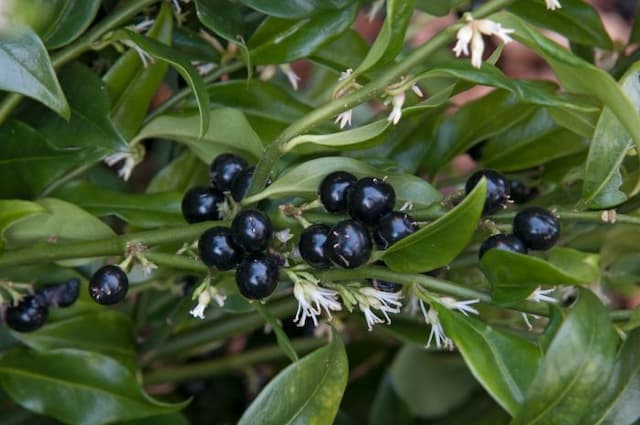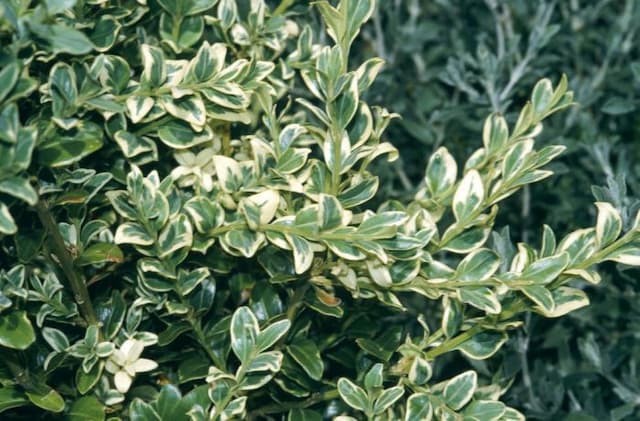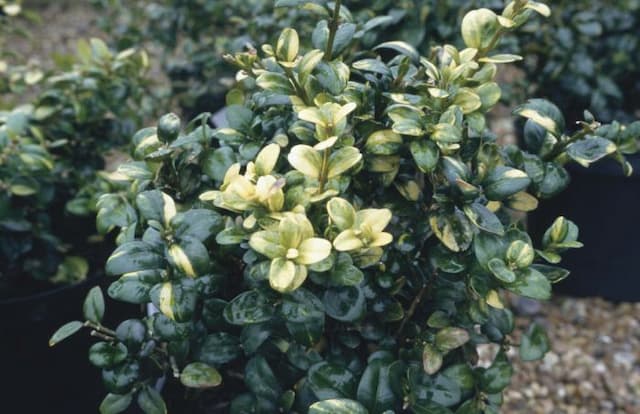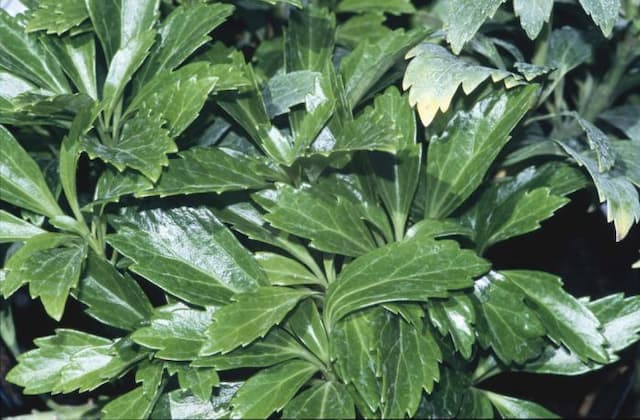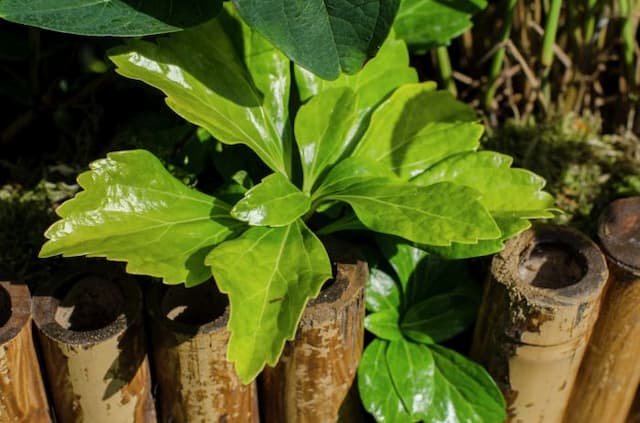Japanese Spurge Pachysandra terminalis

ABOUT
Pachysandra terminalis, commonly known as Japanese spurge, is an evergreen ground cover that presents a lush carpet of rich, green foliage. The leaves of the plant are glossy with a somewhat leathery texture and are arranged in a whorl-like pattern at the stem ends. This gives the plant a dense and bushy appearance. The leaves themselves are oval to oblong in shape and may have finely toothed edges, contributing further detail to the overall texture of the plant. Additionally, Japanese spurge produces tiny white flowers that bloom in small clusters. These blossoms are not particularly showy, but they do add a subtle charm to the plant in the springtime. The overall impression given by Japanese spurge is one of a verdant, ground-hugging tapestry that provides a continuous cover of green throughout the year.
About this plant
 Names
NamesFamily
Buxaceae
Synonyms
Japanese Spurge, Japanese Pachysandra
Common names
Pachysandra crenata, Pachysandra procumbens, Pachysandra terminalis var. crenata, Pachysandra terminalis var. japonica, Pachysandra terminalis var. procumbens.
 Toxicity
ToxicityTo humans
Japanese pachysandra contains compounds that may be toxic if ingested. While there have been few reports of poisoning in humans, consumption of this plant could potentially cause gastrointestinal distress, such as vomiting and diarrhea. As with any non-food plant, it is advisable to avoid ingestion and keep it out of reach of children who might accidentally consume it.
To pets
Japanese pachysandra is considered mildly toxic to pets if ingested. Dogs and cats may experience vomiting, diarrhea, and drooling after consuming parts of the plant. It is prudent to prevent pets from eating it to avoid these unpleasant symptoms. If a pet does consume Japanese pachysandra, it is recommended to consult a veterinarian.
 Characteristics
CharacteristicsLife cycle
Perennials
Foliage type
Evergreen
Color of leaves
Green
Flower color
White
Height
6-12 inches (15-30 cm)
Spread
12-18 inches (30-45 cm)
Plant type
Shrub
Hardiness zones
4-9
Native area
Japan
Benefits
 General Benefits
General Benefits- Ground cover: Pachysandra terminalis, commonly known as Japanese Spurge, effectively covers the ground, preventing soil erosion and suppressing weed growth.
- Shade tolerance: Japanese Spurge thrives in shady areas where other plants might struggle to grow.
- Drought resistance: Once established, it has good drought tolerance, reducing the need for frequent watering.
- Low maintenance: Japanese Spurge requires minimal care once established, making it a convenient choice for gardeners of all skill levels.
- Aesthetic appeal: With its glossy evergreen leaves and small white flowers, it provides year-round visual interest to gardens and landscapes.
- Winter hardiness: It is capable of surviving through cold winters, making it suitable for a variety of climates.
- Rapid spread: It spreads quickly to form dense mats, providing quick cover for large areas.
- Soil improvement: Its dense root system can help improve the structure and nutrient content of the soil over time.
- Habitat support: It offers shelter for small wildlife and beneficial insects within a garden ecosystem.
 Medical Properties
Medical PropertiesThis plant is not used for medical purposes.
 Air-purifying Qualities
Air-purifying QualitiesThis plant is not specifically known for air purifying qualities.
 Other Uses
Other Uses- Pachysandra terminalis, commonly known as Japanese spurge, can be used as a natural dye source for fabrics, yielding subtle green hues.
- In crafts, dried leaves of Japanese spurge can be used for creating eco-friendly confetti or as an inclusion in homemade paper for a natural look.
- Japanese spurge makes a resilient and attractive ground cover for shady areas under trees, where other plants might struggle to grow.
- It can be used in terrariums to create a lush, miniature landscape due to its low-growing and shade-loving nature.
- Landscape artists utilize Japanese spurge in topiary gardens or train it to fill in spaces around sculptures and focal points for an evergreen backdrop.
- This plant can serve as a living mulch, suppressing weeds and helping to retain soil moisture in garden beds or between stepping stones.
- Due to its dense foliage, Japanese spurge can be used to prevent soil erosion on slopes or areas prone to runoff.
- Aquarium enthusiasts sometimes use potted Japanese spurge to add greenery around their aquariums, benefiting from its humidity tolerance.
- Japanese spurge's thick roots can be used as a natural stabilizer for riverbanks or areas susceptible to shifting earth.
- In floral arrangements, cuttings of Japanese spurge can add texture and volume, even though they're not typical flowers.
Interesting Facts
 Feng Shui
Feng ShuiThe Japanese Spurge is not used in Feng Shui practice.
 Zodiac Sign Compitability
Zodiac Sign CompitabilityThe Japanese Spurge is not used in astrology practice.
 Plant Symbolism
Plant Symbolism- Shade Endurance: Often found in shaded or woodland gardens, Pachysandra terminalis, commonly known as "Japanese Spurge," symbolizes resilience and the ability to thrive in less than ideal conditions.
- Growth and Expansion: With its tendency to spread through rhizomes, Japanese Spurge represents growth and the natural drive to expand one's boundaries or influence.
- Safety and Protection: As a dense ground cover, Japanese Spurge can symbolize the idea of creating a protective blanket, offering safety to the area it covers and the organisms it shelters.
- Perseverance: Its evergreen nature and tolerance to poor soils reflect the idea of perseverance and the capability to endure and push through adversity.
 Water
WaterJapanese Spurge should be watered deeply and thoroughly, allowing the soil to become slightly dry between waterings. In general, watering once every week to ten days is sufficient, but this may vary depending on weather conditions. Each watering should provide enough moisture to soak the top 6 to 8 inches of soil, which, for an established bed, translates to about 1 to 1.5 gallons per square yard. It's important to avoid overhead watering to minimize leaf diseases, so direct the water at the soil level. During the hot summer months or in dry spells, you may need to water more frequently to keep the soil consistently moist.
 Light
LightJapanese Spurge thrives best in partial to full shade. It is an excellent ground cover for shady areas beneath trees or on the north side of buildings. The plant can tolerate some morning sun, but too much direct sunlight can scorch the leaves, so it's essential to avoid hot afternoon sun.
 Temperature
TemperatureJapanese Spurge is hardy and can tolerate a temperature range from about -20°F to 90°F, but it prefers cooler temperatures. The ideal temperature for Japanese Spurge falls between 50°F and 70°F. It is best suited for USDA Hardiness Zones 4 through 8, where it can survive winters without much trouble.
 Pruning
PruningPruning Japanese Spurge is not generally necessary, but it can be trimmed to maintain a neat appearance or to remove damaged or diseased foliage. The best time for pruning is early spring or after flowering. Pruning every year or two is usually sufficient for keeping the plant healthy and well-groomed.
 Cleaning
CleaningAs needed
 Soil
SoilJapanese Spurge thrives in a moist, well-drained soil mix with a high organic matter content. A mixture of peat, compost, and pine bark is suitable. The ideal soil pH for Japanese Spurge is slightly acidic to neutral, ranging from 5.5 to 7.0.
 Repotting
RepottingJapanese Spurge, being a ground cover, typically doesn't require repotting. It is usually planted in landscape areas outdoors where it can spread naturally. However, if grown in containers, it may need repotting every 2-3 years to refresh the soil.
 Humidity & Misting
Humidity & MistingJapanese Spurge prefers a moderately humid environment but is quite adaptable to different humidity levels. Ensuring good soil moisture is more crucial than atmospheric humidity for this plant.
 Suitable locations
Suitable locationsIndoor
Place in shaded area with high organic soil.
Outdoor
Plant in shade to partial sun; moist, well-drained soil.
Hardiness zone
4-9 USDA
 Life cycle
Life cyclePachysandra terminalis, commonly known as Japanese Spurge, begins its life cycle when seeds or cuttings are planted in soil. From these, new shoots emerge and establish a root system, with the plant typically sprouting evergreen leaves that form a dense ground cover. The plant matures and becomes ready to reproduce in early spring, producing small white inconspicuous flowers that develop at the tips of its stems. After pollination, typically by insects, these flowers give rise to small berry-like fruits containing seeds. These seeds may be dispersed by gravity or animals, and once they land in a suitable location, they can germinate to start a new plant. The Japanese Spurge also spreads vegetatively through its rhizomes, expanding its growth outward and creating larger colonies over time.
 Propogation
PropogationPropogation time
Spring-Early Summer
Pachysandra terminalis, commonly known as Japanese spurge, is typically propagated during the spring or early fall for optimal results. The most popular method of propagation for this plant is through division, a straightforward and effective technique. To propagate Japanese spurge by division, carefully dig up an established clump and gently separate it into smaller sections, ensuring each has a portion of the root system. Replant these divisions at the same depth they were growing previously, spacing them about 6 to 12 inches (15 to 30 centimeters) apart to give them ample room to spread. Water the newly planted divisions thoroughly to help establish them. With proper care, these divisions will grow to form dense mats, making division not only the most popular but also a highly successful propagation method for Japanese spurge.
